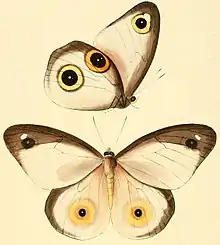Hyantis
Hyantis is a monotypic nymphalid butterfly genus. Its sole species is Hyantis hodeva, which is found in New Guinea. It is uncertain which tribe this butterfly should be placed within.
| Hyantis hodeva | |
|---|---|
.jpg.webp) | |
| Hyantis hodeva helvola | |
| Scientific classification | |
| Kingdom: | |
| Phylum: | |
| Class: | |
| Order: | |
| Family: | |
| Tribe: | |
| Genus: | Hyantis |
| Species: | H. hodeva |
| Binomial name | |
| Hyantis hodeva Hewitson, 1862[1] | |
Distribution
The species is distributed in the following islands: New Guinea, Waigeo, Misool, Yapen and D'Entrecasteaux Islands.[2]
Morphology

The species has three pairs of six well-developed ocellus on the ventral side of the wings: one pair on the forewings near the apex and two pairs on the hindwings.[2] Each eyespot is large and bordered with yellow, and the black "pupil" has plural small white dots inside.[2][4] This species is similar to Taenaris, but can be easily identified from that genus, which generally has only two or four ocellus with single white spot on its hindwings.[2]
This species is also unique in having a closed discoidal cell on each hindwing.[2][4] This morphological character is also shared by the genus Morphopsis and is generally found in the subfamily Satyrinae.[2]
The early stage is unknown.[2]
Mimicry
This species is very similar to Taenaris species, especially T. catops. Hyantis is also imitated by Mycalesis drusillodes (Satyrini), Taenaris by Elymnias agondas (Elymniini). It should be considered that these species may be involved in some kind of mimicry complex, but the details are not known.[2]
Systematics
The genus Hyantis (and putatively related Morphopsis) has traditionally been placed within tribe Amathusiini,[5] even though there are differences in wing venation structures.[6] Recent molecular phylogenetic analyses have been gradually resolved the confusion in the phylogenetic relationships in the subfamily Satyrinae[7][lower-alpha 2], but the phylogenetic status of this genus remains confused, with several methods of analysis showing different results.[5] For example: within the clade of Melanitini + Dirini (Peña & Wahlberg 2008), appears to be related with Elymnias (Wahlberg et al. 2009, Fig.1s), as sister to Amathusiini (Wahlberg et al. 2009, Fig.5s) and within Zetherini (Wahlberg et al. 2009, Fig.3s and Penz 2017). In any case, further studies are needed to clarify the phylogenetic position of this genus.[5]
Classification
This species contains 3 to 5 subspecies.[2] The lower classification shown here is according to Wahlberg (2018), which recognizes 4 subspecies.
- Hyantis Hewitson, 1862
- Hyantis hodeva Hewitson, 1862
- Hyantis hodeva hodeva Hewitson, 1862
- Hyantis hodeva helvola Stichel, 1905 (syn. Hyantis hodeva hageni Röber, 1903)
- Hyantis hodeva fulginosa Grose-Smith, 1898 (syn. Hyantis hodeva xanthophthalma Röber, 1903)
- Hyantis hodeva emarginata Fruhstorfer, 1916
Notes
- These illustrations are signed "W.C. Hewitson del et lith. 1862". "del et lith." is a signature indicating by whom the illustration was drawn and printed on the lithograph.[3] Thus, this illustrations were drawn and printed on the lithograph by Hewitson in 1862 (although the whole book was published between 1868 and 1871).
- The tribes that formed subfamily Morphinae, such as tribe Amathusiini, are now included in the subfamily Satyrinae based on molecular phylogenetic analyses.[5][7]
References
Citations
Sources
- Brower, Andrew V.Z. (2006). "Hyantis hodeva Hewitson 1862. Version 09 November 2006 (temporary)". The Tree of Life Web Project.
- Hewitson, William C. (1867–1871). "MORPHIDAE. DRUSILLA & HYANTIS". Illustrations of new species of exotic butterflies : selected chiefly from the collections of W. Wilson Saunders and William C. Hewitson. Vol. 4.
- Marín, M.A.; Peña, C.; Freitas, A.V.L.; Wahlberg, N.; Uribe, S.I. (2011). "From the Phylogeny of the Satyrinae Butterflies to the Systematics of Euptychiina (Lepidoptera: Nymphalidae): History, Progress and Prospects". Neotropical Entomology. 40 (1): 1–13. doi:10.1590/S1519-566X2011000100001. PMID 21437476.
- Peña, Carlos; Wahlberg, Niklas (2008). "Prehistorical climate change increased diversification of a group of butterflies" (PDF). Biology Letters. 4 (3): 274–278. doi:10.1098/rsbl.2008.0062. PMC 2610051. PMID 18364308.
- Penz, Carla M. (2017). "Exploring Color Pattern Diversification in Early Lineages of Satyrinae (Nymphalidae)". In Sekimura, T.; Nijhout, H. (eds.). Diversity and Evolution of Butterfly Wing Patterns. Springer. p. 21-37. doi:10.1007/978-981-10-4956-9_2. ISBN 978-981-10-4956-9.
- Savela, Markku. "Hyantis Hewitson, 1862". Lepidoptera and some other life forms.
- Shimomura, Hiroshi (2015). "13. Genus Hyantis Hewitson, [1862]" ムツメメダマ属. ワモンチョウ族のモノグラフ 第5版 [web monograph of tribe Amathisiini ver.5] (in Japanese).
- Wahlberg, Niklas; Leneveu, Julien; Kodandaramaiah, Ullasa; Peña, Carlos; Nylin, Sören; Freitas, André V.L.; Brower, Andrew V.Z. (2009). "Nymphalid butterflies diversify following near demise at the Cretaceous/Tertiary boundary". Proceedings of the Royal Society B. 276 (1677): 4295–4302. doi:10.1098/rspb.2009.1303. PMC 2817107. PMID 19793750.
- Wahlberg, N.; Leneveu, J.; Kodandaramaiah, U.; Peña, C.; Nylin, S.; Freitas, A. V.; Brower, A. V. (2009), "Supplemental Material" (PDF), Proceedings. Biological Sciences, 276 (1677): 4295–4502, doi:10.1098/rspb.2009.1303, PMC 2817107, PMID 19793750
- Wahlberg, Niklas. "The Nymphalidae Systematics Group". Retrieved 2021-10-21.
- Peña, Carlos; Wahlberg, Niklas. "Satyrinae". NYMPHALIDAE.net. Retrieved 2021-10-21.
- Wahlberg, Niklas (2018). "Amathusiini". NYMPHALIDAE.net. Retrieved 2021-10-21.
External links
- Hyantis hodeva Hewitson 1862 at the Tree of Life web project
- Hyantis Hewitson, 1862 at Lepidoptera and some other life forms
- Genus Hyantis Hewitson, [1862] in the Web Monograph about tribe Amathusini (in Japanese)